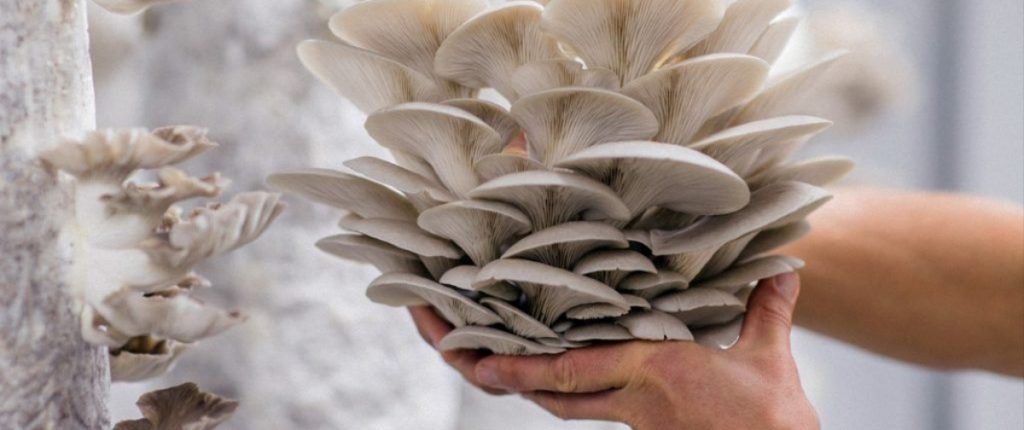Watching your first mushrooms grow is exciting and intriguing as many species grow very fast, doubling in size daily.
But when is the right time to harvest them?
People often ask us this question, and it’s important, as harvesting mushrooms at the ideal time gives you a good yield with the best possible flavor and texture.
Read on to learn when to harvest mushrooms, the different techniques you can use and how to harvest some of the most popular cultivated mushroom species.
When Should You Harvest Mushrooms?
When harvesting mushrooms, you’re trying to balance letting them grow in size to get a good yield without letting them become too mature.
Bigger isn’t always better!
The ideal point of harvest looks different for each mushroom variety and is something you learn through experience…usually by harvesting too late a few times!
How do you know when mushrooms are done growing?
Signs of maturity in mushrooms are generally the caps flattening or becoming convex and the gills enlarging and dropping spores.

When to Harvest Oyster Mushrooms
The ideal time to harvest oyster mushrooms is not determined by size but rather by the shape of their caps.
It’s best to harvest oyster mushrooms when the caps begin to uncurl and flatten, but before they become too flat.
The edges of your oyster mushroom caps should still be slightly curled under when you harvest them.
It can be hard to judge the first time you grow oyster mushrooms, but with practice, you’ll learn when they’re ready to harvest.
You know you’ve waited too long if they stop growing in size, start drying out or release a lot of fine, white dust-like spores.
The good news is you can still eat these very mature mushrooms, but they won’t last as long after harvest, and their texture may not be as good.
Harvesting oyster mushrooms when the edges of their caps are still slightly rolled under limits the number of spores they release, which is beneficial when growing them indoors.
The video below will help you recognize the ideal point of harvest for oyster mushrooms.
When to Harvest Blue Oyster Mushrooms
The ideal time to harvest blue oyster mushrooms is when the edges of the caps of the largest mushrooms in the cluster start to uncurl and flatten out.
This is usually about 6 to 10 days after pinning, which is when tiny blue oyster mushrooms first appear.
Oyster mushrooms grow very fast, so the difference between harvesting too late or too early is often only a few hours.
As your blue oysters get closer to maturity, it’s a good idea to check on them regularly.
And, if you’re not sure, rather harvest them a little early to avoid cleaning up mushroom spores.
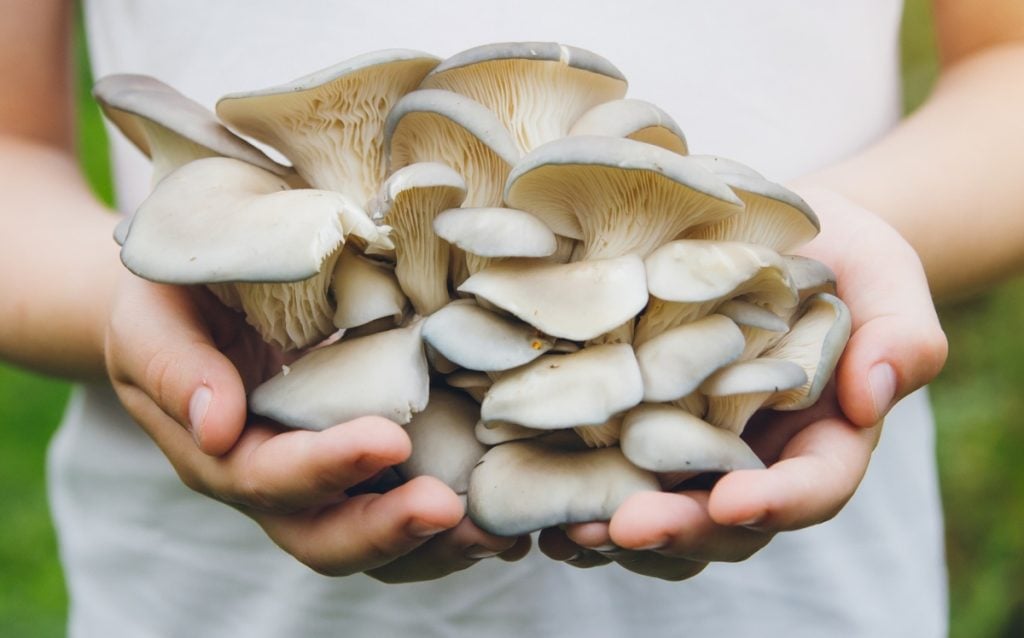
When to Harvest Pink Oyster Mushrooms
The best time to harvest pink oyster mushrooms is when the cap is flat or slightly concave, and the edges are just beginning to curl up.
Pink oyster mushrooms are the fastest growing of all oyster mushrooms and also produce the most spores, so it’s important to harvest them before they cover everything in pink dust.
Pink oyster mushrooms could be ready to harvest in as little as 4 to 5 days from when mushroom pins started to form.
You can also harvest pink oysters before the caps start to flatten, especially if they’re already a good size. The younger your pink oysters, the more tender and succulent they’ll be.
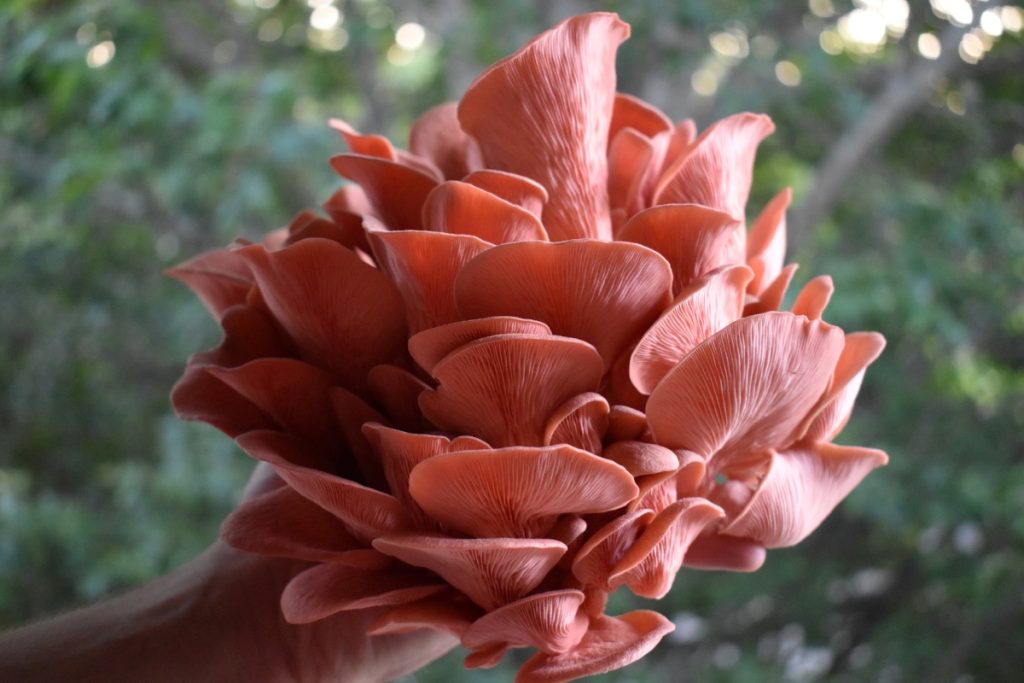
When to Harvest Shiitake Mushrooms
The ideal stage to harvest shiitake mushrooms is when the edges of the caps are still curled under, and 80% of the gills are exposed.
But, you can harvest shiitake mushrooms at any time during their growth, regardless of size.
An easy way to tell if they’re ready for harvest is to check if the partial veil has broken, exposing the gills.
Leave young shiitakes with intact veils to continue growing and only harvest them once you can see their gills.
Mature shiitakes, with flat caps and white or slightly speckled gills, are not great for transporting or sales, but they’re still delicious and fabulous for grilling.
But, if you come across very mature shiitakes with gills that have turned brown, do not eat them.
If you’re still not sure, have a look at this video from Field and Forest Products that shows you when to harvest shiitake mushrooms.
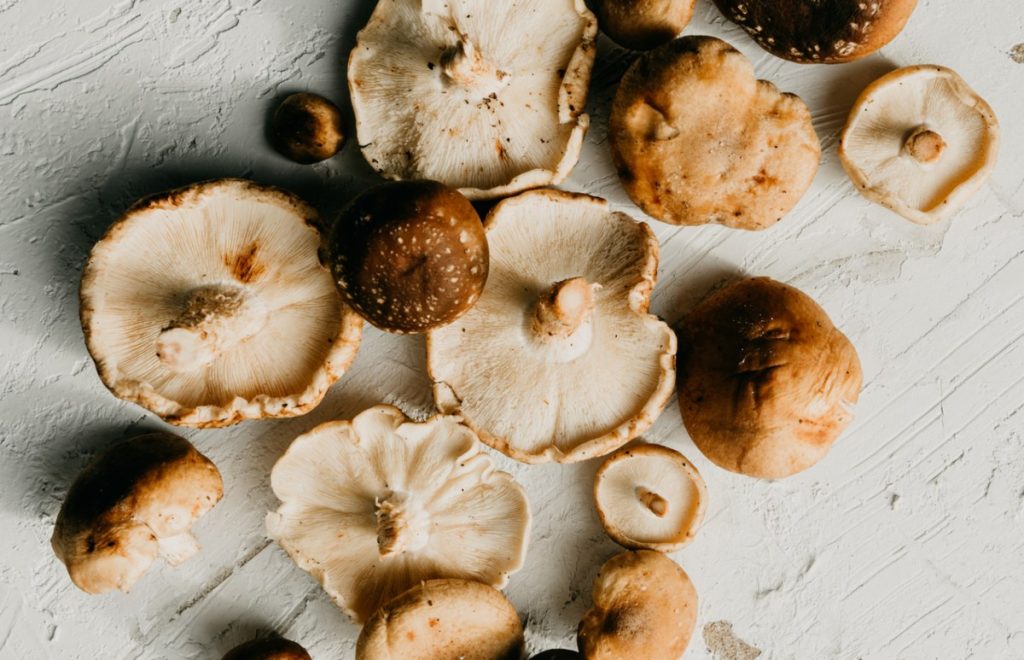
When to Harvest Lion’s Mane Mushrooms
Lion’s mane mushrooms are generally ready to harvest four to seven days after pinning.
When your lion’s mane mushrooms are around fist size with distinct, elongated spines or teeth, they’re ready to harvest.
Lion’s mane spines can grow up to an inch (2.54cm) in length, but many growers recommend harvesting them when their spines are around 0.25 inches (0.6cm) long.
For the best flavor and texture, harvest your lion’s mane before they begin to dry out and turn a brown or pinkish color.
As lion’s mane mushrooms grow, their texture changes. Younger lion’s mane mushrooms are firmer and denser than mature lion’s mane.
Try picking them at different stages to sample the different textures and see which you enjoy most.
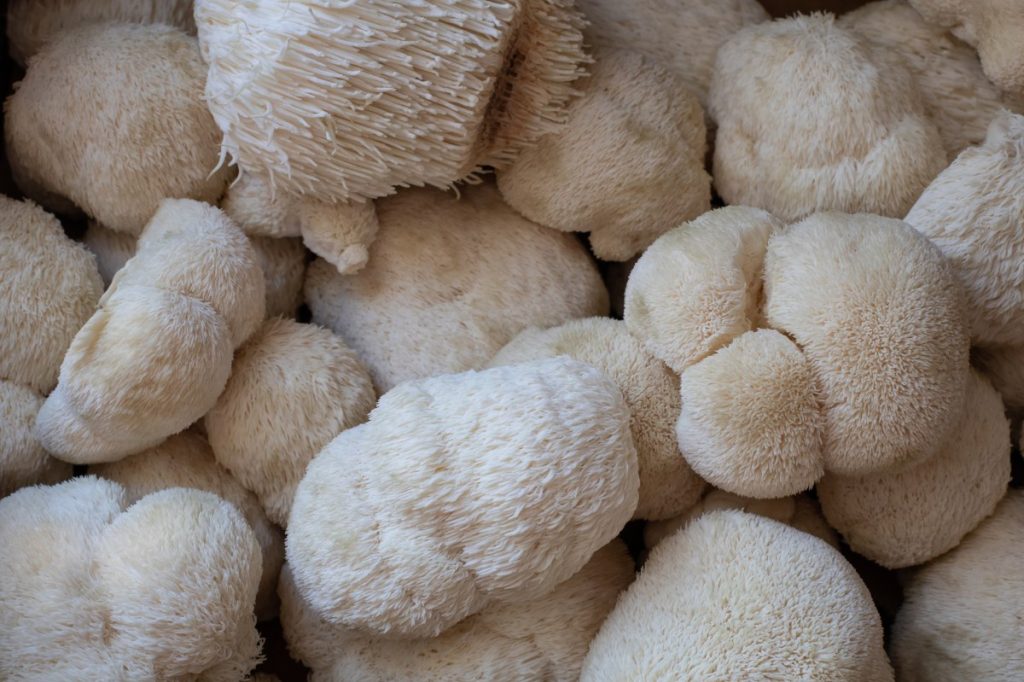
How to Harvest Mushrooms
There are a few ways to harvest mushrooms. Which is best depends on the type of mushrooms and your preferred harvesting technique.
Harvesting Techniques: Picking vs Cutting
New mushroom growers often ask, “should you cut or pull mushrooms?”
Mycophiles, who love and harvest wild edible mushrooms, also often debate this point.
But studies have shown that it makes little difference to future mushroom production.
Those who favor cutting believe it causes less damage to the mushroom mycelium.
Cutting also reduces the time spent cleaning your mushrooms as you don’t have the dirt and debris that’s often attached to the base of a mushroom stem.
Although many foragers prefer cutting, there are a few potential benefits to pulling wild mushrooms, including:
- Saving energy – Pulling out the entire mushroom signals to the fungus that the mushroom is gone, so it can divert any energy to produce more mushrooms.
Cutting leaves an exposed piece of stem that may still receive energy from the fungus for a while.
- Helping with identification – Pulling or plucking mushrooms can help you identify certain mushroom species.
Sometimes you’ll find significant clues, such as different colors at the stem’s base or the remnants of a universal veil under the soil.
You can only see these characteristics if you pull up the entire mushroom.
- Preventing infection – Cutting with a knife leaves an exposed piece of stem that could be a potential infection site for bacteria or other fungi.
When it comes to cultivated mushrooms, you can harvest either way.
Whether you harvest mushrooms by cutting or pulling, it’s always important to be gentle, as mushrooms bruise easily.
If you harvest and handle mushrooms carefully, they’ll last much longer when stored correctly in the fridge.
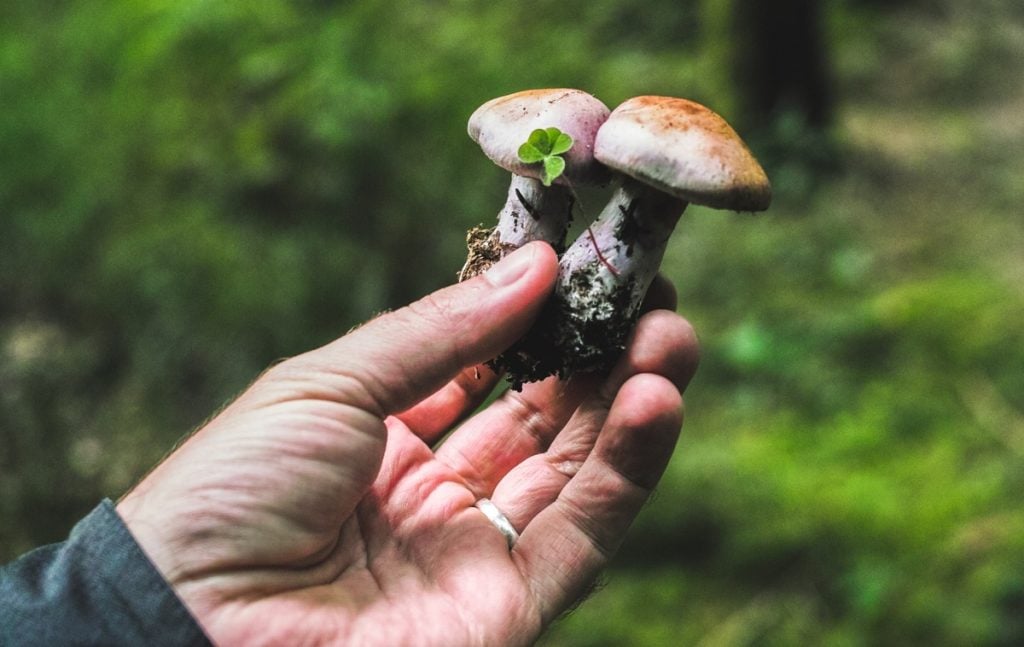
What Is The Best Way to Harvest Mushrooms?
The best way to harvest mushrooms depends on the type of mushroom you’re growing.
Twisting and pulling by hand is the easiest way to harvest some varieties, including button, cremini, oyster, chestnut, pioppino and lion’s mane mushrooms.
But, it’s best to harvest other varieties, like shiitake and reishi mushrooms, by cutting them with a sharp knife or scissors.
Where Do You Cut Mushrooms When Harvesting?
When using a knife to harvest mushrooms, mycologists generally recommend cutting the stem as close to the base as possible.
But, exactly where to cut will depend on the type of mushrooms you’re harvesting.
If you’re harvesting mushrooms that grow in small clumps with stems joined at the base, like chanterelles, you can cut mushrooms off individually.
Foragers recommend cutting mature chanterelle mushrooms at the bottom of their stems, leaving the base and any smaller mushrooms to grow.
But, with some species, like chestnut, oyster and pioppino, the individual mushrooms in a cluster are tightly packed.
And it’s best to cut the entire mushroom cluster off the substrate at the base.
Harvesting individual mushrooms from tight clusters without bruising or breaking other mushrooms is often impossible.
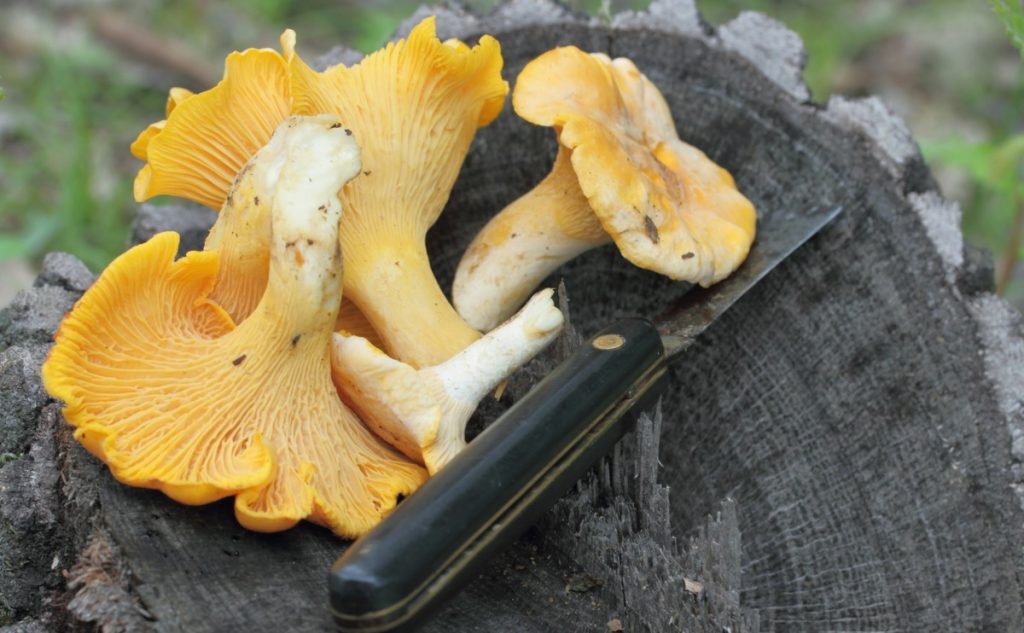
Do Mushrooms Regrow After Harvest?
Yes, most mushroom varieties will grow a second and sometimes a third crop or flush after the first harvest.
How to Harvest Oyster Mushrooms
Oyster mushrooms are some of the easiest mushrooms to grow and the most popular with beginner mushroom growers.
To harvest your oyster mushrooms, you can gently twist and pull the cluster of oyster mushrooms off with your hands or carefully cut it off with a knife.
If you harvest oyster mushrooms with a knife, cut the cluster off as close to the substrate block as possible without damaging the substrate or grow bag.
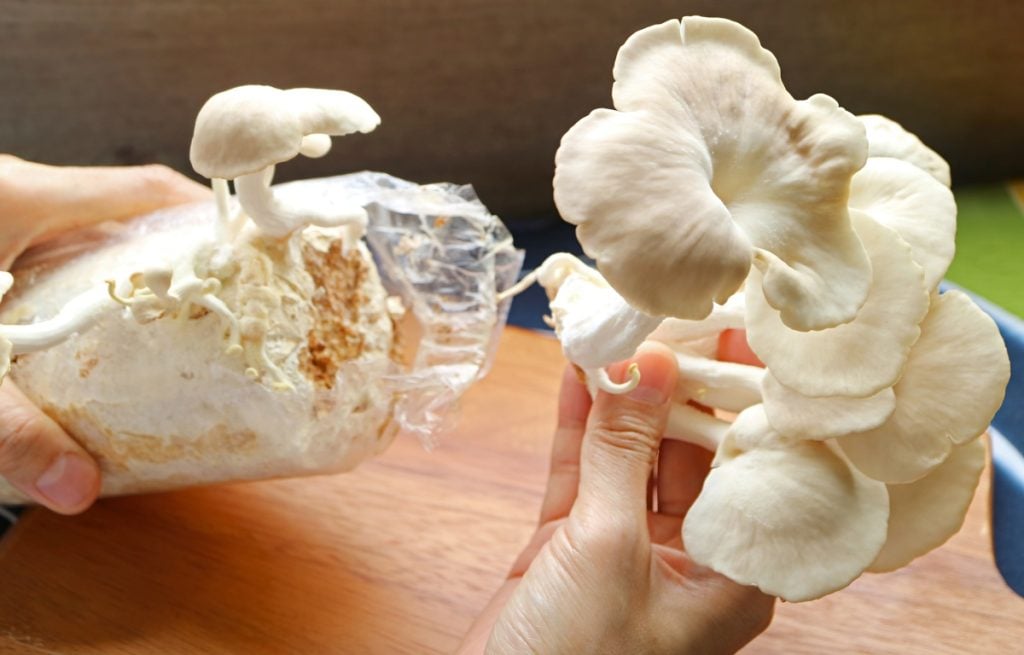
How to Harvest Shiitake Mushrooms
The best way to harvest shiitake mushrooms is by cutting them with a knife or scissors as close as possible to the substrate block or log.
But, be careful not to damage the substrate as shiitakes produce several flushes, and any damage may limit future growth.
Cutting shiitakes helps prevent pieces of substrate or other debris from getting into their gills after harvest.
It also helps to prevent potential contamination or damage to the mycelium that could impact future flushes.

How to Harvest Lion’s Mane Mushrooms
When harvesting lion’s mane, you can either gently twist and pull them off at the base or cut them off close to the base with a sharp knife.
We recommend gently twisting them off as it can often be difficult to get a knife in behind the fruitbody. If the mushrooms are ready for harvest they will come off very easily as you twist and gently pull away from the substrate.
Handle the freshly harvested Lions Mane carefully as it can bruise easily, which makes lion’s mane look less appealing, but they’re still safe to eat unless you leave them in the fridge too long and they go bad.
Final Thoughts
The ideal point of harvest is different for different mushroom species, and knowing exactly when to harvest them is something you’ll learn through experience.
If you’re growing mushrooms as a hobby and not too concerned about yields, try harvesting mushrooms at different stages to experience any changes in flavor and texture.
To learn more about growing mushrooms at home without expensive equipment, visit our Mushroom Growing Hub or try one of our mushroom cultivation courses.
